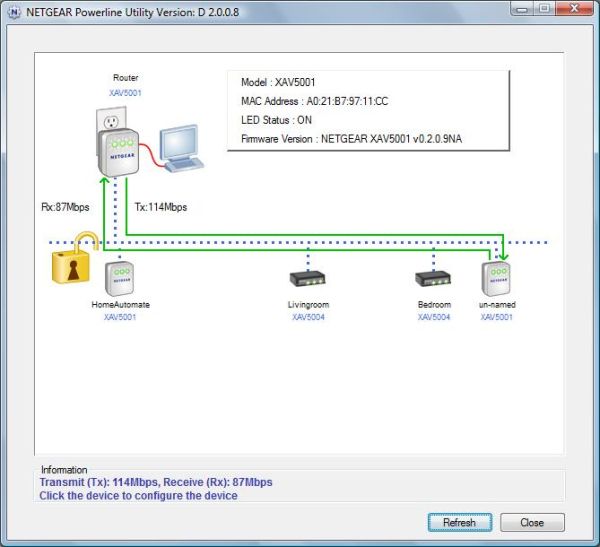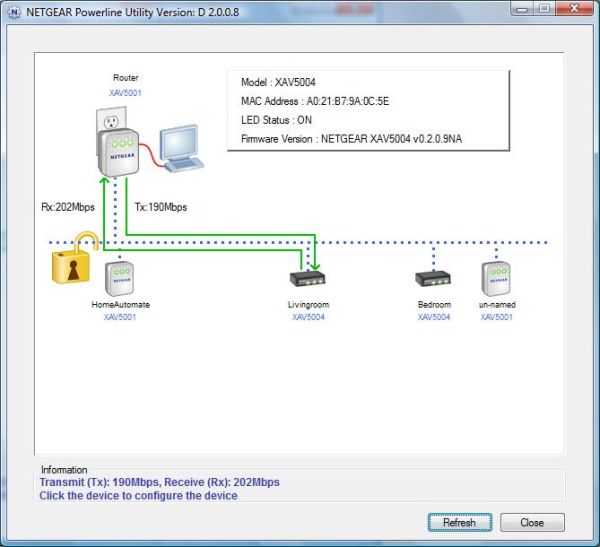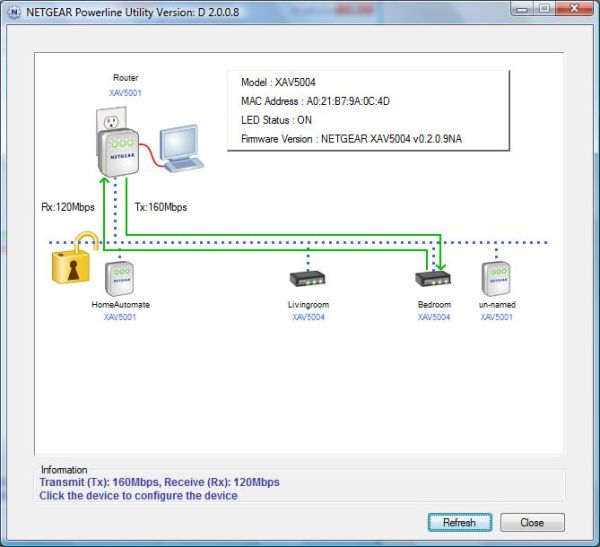Hands-On Powerline Networking: How Well (Or Not) Are Latest-Generation Devices Working?
by Brian Dipert on September 1, 2011 12:41 AM EST- Posted in
- Networking
- Powerline Adapters
- NetGear
I also ran 72 tests' worth of UDP measurements, leveraging the Ixia-supplied UDP_Throughput.scr script as-is in the four-stream case. For single-stream UDP tests, I modified UDP_Throughput. scr, increasing the per-stream data-payload size from 730 KBytes to 7.3 MBytes in order to lengthen the tests' runtimes. After all, as I previously mentioned, newer powerline technologies focused their performance-improvement attention on UDP, which finds use in streaming large-payload multimedia content from one network client to another. And you can find my UDP testing results reports in the earlier-mentioned ZIP archive.
But I've decided not to publish the average bandwidth measurements in a table, as I did one page back with the TCP results. That's because, in every testing case, only a few packets succeeded in making their way from one Endpoint to the other, translating to a near-100% packet loss scenario. To be clear, this underwhelming outcome did not occur due to any inherent HomePlug AV or IEEE 1901 UDP incompatibility; as I type these words, for example, I'm watching a video streamed from a computer to my television over an AR7400-implemented powerline spur and using UDP. But after a few moments' reflection, I came up with a seemingly plausible explanation, which a subsequent chat conversation with Brian Klug sanity-checked and an email back-and-forth with Ixia's Michael Githens confirmed.
The issue, as networking wizards among you out there may have already figured out, is that by definition, UDP is (in the words of Brian Klug) 'connectionless'. This means less protocol overhead, but with UDP being a best-effort approach, it's possible for an abundance of packets to get dropped due to transmission channel bandwidth limitations...that is, unless the transmitter is somehow (at the application layer) able to monitor the receiver's success-or-failure statistics and (if necessary) back off its packet-output rate. Windows Media Center, for example, does this; if necessary, it'll more aggressively compress video (for lower per-frame average bitrate, at the tradeoff of reduced image quality) and/or drop frames in order to match its transmission speed to the channel and receiver's capabilities.
IxChariot unfortunately doesn't seem to include destination-cognizance features such as these. All it seemingly knows is that, for example, the two HomePlug AV adapters I tested are reporting 100 Mbps PHY rate capabilities, with the XAV5001 adapters touting GbE speeds, and it subsequently sends out packets at much faster rates than the powerline spur is capable of reliably routing to their destination. Here's what Ixia's Michael Githens said when I explained my predicament and theory as to its root cause:
Unfortunately there isn't anything built into IxChariot to automatically help you figure out that no-drop rate. You could, however, script it to do a test, check results and change an input value to have it do multiple runs for you so that you can zero in on the no-drop rate. That would be the best I could suggest.
Such an iterative approach is actually something I'd considered, but its tedious and time-consuming aspects make it unattractive for the involved testing suite that I tackled in this project. And unfortunately, Brian Klug reports that iPerf is seemingly similarly destination-unaware in its consequently 'blind' UDP testing approach. I welcome reader suggestions on utilities or other techniques that will measure the peak no-packet-drop UDP bitrate without excessively burdening the source-to-destination channel (thereby under-representing the channel's UDP potential). Applications that are Mac OS X-cognizant are particularly welcome, since the only two GbE-capable laptops in my possession are Macs, neither of which has Windows optionally installed via Boot Camp. Please leave a comment on this writeup, or drop me an email.
For whatever it's worth, I'll wrap up this particular page by passing along the four router-to-node screenshots of 'raw' measured bandwidth potential that Netgear's Powerline Utility (Windows version; here's the Mac edition) measures for my AR7400-based XAV5001-plus-XAV5004 powerline network, from the router-based adapter to each of the four other network nodes.
Node 1
Node 2
Node 3
Node 4














53 Comments
View All Comments
fkoehler - Saturday, September 3, 2011 - link
Seriously, as a networking guy who's been following this since well before 2004, this has to be one of the worst article I've ever read on the subject.
And equally as annoying is that its on AT and the goofy tone and copy/pasta of chunks of text.
All you appear to have done is repeat rote basics regarding powerline networking, most of which has been written before numerous times.
I fail to see anything useful, new, or even interesting in this article.
Hey, maybe AT can pay me to write about Cisco IOS or Routers, and I'll paste large swathes of text into my article just to dumbfound the readers and appear techy/edgy....
I wouldn't call you a Luddite, just a p-ss poor writer with obvious feelings of technical superiority. Considering your stupid comment re: Ethernet, I have the same level of faith in anything else you comment on.
The majority of this article could have been compressed into 2-3 Introductory paragraphs. Everyone even moderately interested in the technology has known there are only 2 players in this market.
I guess AT is doing the old TomsHardware thing and going for rehashed quantity over quality.
EddieCFS - Friday, November 9, 2012 - link
Problem : Boutique Hotel 4 floors,10 rooms per floor . No additional cabling allowed .Is it possible to have four networks ; one per floor ? . How do you "isolate " network from each other if sharing a common CB ?. ( Requirement is up to 10Mbps per room )
Maxx11 - Sunday, January 20, 2013 - link
Hello ,I know this thread is kinda old, but I will ask regardless...
I have two older Panasonic HD-PLC PA100 units. Are these new units you tested in article better -- is it worth upgrade ? Are there even better units available now ?
Also, are these tested units better than Panasonic HD-PLC when used between breakers with different phase power ? (my experience has been they are almost useless in this situation, which may account for more than half the normal cases)
Thanks for any info...
Maxx